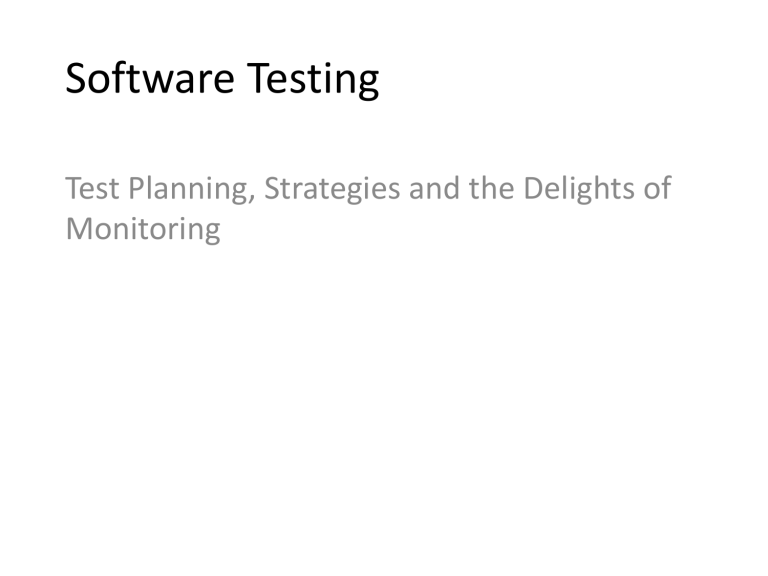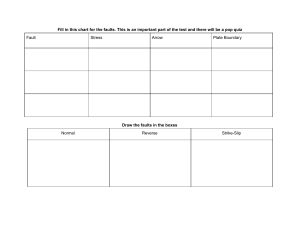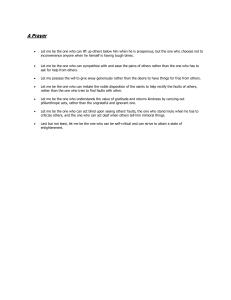
Software Testing Test Planning, Strategies and the Delights of Monitoring What are Planning and Monitoring? • Planning: – Scheduling activities (what steps? in what order?) – Allocating resources (who will do it?) – Devising unambiguous milestones for monitoring • Monitoring: Judging progress against the plan – How are we doing? • A good plan must have visibility : – Ability to monitor each step, and to make objective judgments of progress – Counter wishful thinking and denial Quality and Process • Quality process: set of activities and responsibilities – focused primarily on ensuring adequate dependability – concerned with project schedule or with product usability • A framework for – selecting and arranging activities (especially testing) – considering interactions and trade-offs (e.g., more testing, less review) • Follows the overall software process in which it is embedded – Example: waterfall software process ––> “V model”: unit testing starts with implementation and finishes before integration – Example: XP and agile methods ––> emphasis on unit testing and rapid iteration for acceptance testing by customers Example Process: Cleanroom Customer Requirements Specification Function Functional specifications Formal Design Correctness Verification Usage Incremental Development Planning Source code Statistical test case generation Test cases Statistical testing Interfail times Improvement Feedback Usage specifications Quality Certification Model MTTF statistics Example Process: Cleanroom Customer Requirements Activities and responsibilities focused on quality Functional specifications Formal Design Correctness Verification Specification Function Usage Incremental Development Planning Source code Usage specifications Statistical test case generation Test cases Statistical testing Interfail times Improvement Feedback Integrated into an overall development process Quality Certification Model MTTF statistics Example Process: Software Reliability Engineering Testing (SRET) Define “Necessary” Reliability Development Operational Profiles Prepare for Testing Execute tests Requirements and Architecture Design and Implementation Interpret Failure Data System Test and Acceptance Test Software Reliability Engineering Testing (SRET) Define “Necessary” Reliability Activities and responsibilities focused on quality Development Operational Profiles Integrated into an overall development process Requirements and Architecture Prepare for Testing Execute tests Design and Implementation Interpret Failure Data System Test and Acceptance Test Example Process: Extreme Programming (XP) Incremental Release Next version Review, Refine, prioritize Generate User Stories Passed all unit tests Create Unit Tests pass Pair Programming + unit testing Passed all unit tests Failed acceptance test Create Acceptance Tests Acceptance Testing Extreme Programming (XP) Review, Refine, prioritize Activities and responsibilities focused on quality Generate User Stories Incremental Release Next version Passed all unit tests Create Unit Tests pass Pair Programming + unit testing Passed all unit tests Failed acceptance test Create Acceptance Tests Integrated into an overall development process Acceptance Testing Overall Organization of a Quality Process • Key principle of quality planning – the cost of detecting and repairing a fault increases as a function of time between committing an error and detecting the resultant faults • therefore ... – an efficient quality plan includes matched sets of intermediate validation and verification activities that detect most faults within a short time of their introduction • and ... – V&V steps depend on the intermediate work products and on their anticipated defects Class exercise • Time for some speculation! • Answer these questions: – Do you believe that cost of repair for faults increases as development time progresses? – Are there exceptions? – Can you choose your engineering process to help detect faults earlier? • Take about 2-3 minutes on this 11 End Products • Ultimately we want to deliver an end product of high quality. • But it takes time and steps to get there. • Intermediate artifacts are developed. – Early designs, prototypes, test plans, … • If these are of poor quality, then is it likely that the end product will be of lower quality than we might like? 12 Verification Steps for Intermediate Artifacts • Internal consistency checks – compliance with structuring rules that define “well-formed” artifacts of that type – a point of leverage: define syntactic and semantic rules thoroughly and precisely enough that many common errors result in detectable violations • External consistency checks – consistency with related artifacts – Often: conformance to a “prior” or “higher-level” specification • Generation of correctness conjectures – Correctness conjectures: lay the groundwork for external consistency checks of other work products – Often: motivate refinement of the current product Strategies vs Plans Strategy Plan Scope Organization Project Structure and content based on Organization structure, Standard structure experience and policy prescribed in over several projects strategy Evolves Slowly, with Quickly, adapting to organization and policy project needs changes Test (and Analysis) Strategy • Lessons of past experience – an organizational asset built and refined over time • Body of explicit knowledge – more valuable than islands of individual competence – amenable to improvement – reduces vulnerability to organizational change (e.g., loss of key individuals) • Essential for – avoiding recurring errors – maintaining consistency of the process – increasing development efficiency Considerations in Fitting a Strategy to an Organization • Structure and size – Example • Distinct quality groups in large organizations, overlapping of roles in small ones • Greater reliance on documents in large than small organizations • Overall process – Example • Cleanroom requires statistical testing and forbids unit testing – fits with tight, formal specs and emphasis on reliability • XP prescribes “test first” and pair programming – fits with fluid specifications and rapid evolution • Application domain – Example • Safety critical domains may impose particular quality objectives and require documentation for certification (e.g,RTCA/DO-178B standard requires MC/DC coverage) Elements of a Test Strategy • Common quality requirements that apply to all or most products – unambiguous definition and measures • Set of documents normally produced during the quality process – contents and relationships • Activities prescribed by the overall process – standard tools and practices • Guidelines for project staffing and assignment of roles and responsibilities Test Strategies • The objective of testing is to decrease the risks inherent in computer systems • The strategy must address the risks and present a process that can reduce those risks – Hence, the system risks establish the objectives for the test process • The two components of the testing strategy are the test factors and the test phase: – Test factor: The risk or issue that needs to be addressed as part of the test strategy – Test phase: The phase of the systems development life cycle in which testing will occur 18 Test Strategies • Test factors: Correctness, File integrity, Authorization, Audit trail, Availability, Access control, Compliance, Reliability, Ease of use, Maintainability, Portability, Coupling, Performance, Ease of operation, etc. • Not all test factors will be applicable to a software system • The development team will need to select and rank the test factors for the specific software system being developed • Once selected and ranked, the strategy for testing will be partially defined • The test phase will vary based on the testing methodology used 19 So how do you build a strategy? 1. Select and rank test factors: The customers/key users of the system in conjunction with the test team should select and rank the test factors 2. Identify the system development phases: This is normally obtained from the system development methodology 3. Identify the business risks associated with the system under development: The developers, key users, customers, and test personnel should brainstorm the risks associated with the software system 4. Place risks in Test factor/test Phase: The risk team should determine the test phase in which the risk needs to be addressed by the test team, and the test factor to which the risk is associated 20 Test Strategy – like this! SFWR ENG 3S03 Software Testing Maintenance Sys./Accp. Testing (Slide 28 of 36) Integration Testing Unit Testing Coding Factors Design Test Arch. Design Test Phase Requirements Testing Strategies and Plans ÂTest Strategy ÂDeveloping a Test Strategy Dr. R. Khedri Outline Preliminaries Errors, Defects, Failures Computer System Strategic Risks an Economics of Testing Establishing a Testing Policy Factors Risks Test Strategy Developing a Test Strategy Developing a Testing Plan Dr. R. Khedri SFWR ENG 3S03: Software Testing 21 Test (and Analysis) Plan Answers the following questions: • What quality activities will be carried out? • What are the dependencies among the quality activities and between quality and other development activities? • What resources are needed and how will they be allocated? • How will both the process and the product be monitored? Main Elements of a Test Plan • Items and features to be verified – Scope and target of the plan • Activities and resources – Constraints imposed by resources on activities • Approaches to be followed – Methods and tools • Criteria for evaluating results Quality Goals • Expressed as properties satisfied by the product – must include metrics to be monitored during the project – example: before entering acceptance testing, the product must pass comprehensive system testing with no critical or severe failures – not all details are available in the early stages of development • Initial plan – based on incomplete information – incrementally refined Task Schedule • Initially based on – test strategy – past experience • Breaks large tasks into subtasks – refine as process advances • Includes dependencies – among quality activities – between quality and development activities • Guidelines and objectives: – schedule activities for steady effort and continuous progress and evaluation without delaying development activities – schedule activities as early as possible – increase process visibility (how do we know we’re on track?) Sample Schedule Schedule Risk • critical path = chain of activities that must be completed in sequence and that have maximum overall duration – Schedule critical tasks and tasks that depend on critical tasks as early as possible to • provide schedule slack • prevent delay in starting critical tasks • critical dependence = task on a critical path scheduled immediately after some other task on the critical path – May occur with tasks outside the quality plan (part of the project plan) – Reduce critical dependences by decomposing tasks on critical path, factoring out subtasks that can be performed earlier Reducing the Impact of Critical Paths Task name CRITICAL SCHEDULE Project start Analysis and design Code and integration Design and execute subsystem tests Design and execute system tests Produce user documentation Product delivery January Febrary March April May Reducing the Impact of Critical Paths Task name UNLIMITED RESOURCES Project start Analysis and design Code and integration Design subsystem tests Design system tests Produce user documentation Execute subsystem tests Execute system tests Product delivery January Febrary March April May Reducing the Impact of Critical Paths Task name LIMITED RESOURCES Project start Analysis and design Code and integration Design subsystem tests Design system tests Produce user documentation Execute subsystem tests Execute system tests Product delivery January Febrary March April May Risk Planning in Building a Plan • Risks cannot be eliminated, but they can be assessed, controlled, and monitored • Generic management risk – personnel – technology – schedule • Quality risk – development – execution – requirements Personnel Example Risks Control Strategies • Loss of a staff member (“the bus”) • Staff member underqualified for task • cross training to avoid overdependence on individuals • continuous education • identification of skills gaps early in project • competitive compensation and promotion policies and rewarding work • including training time in project schedule Technology Example Risks • High fault rate due to unfamiliar COTS component interface • Test and analysis automation tools do not meet expectations Control Strategies • Anticipate and schedule extra time for testing unfamiliar interfaces. • Invest training time for COTS components and for training with new tools • Monitor, document, and publicize common errors and correct idioms. • Introduce new tools in lower-risk pilot projects or prototyping exercises Schedule Example Risks Control Strategies • Inadequate unit • Track and reward quality unit testing leads to testing as evidenced by low fault unanticipated expense densities in integration and delays in • Set aside times in a weekly integration testing schedule in which inspections take • Difficulty of scheduling precedence over other meetings meetings makes and work inspection a • Try distributed and asynchronous bottleneck in inspection techniques, with a development lower frequency of face-to-face inspection meetings Test Execution Example Risks Control Strategies • Execution costs higher than planned • Scarce resources available for testing • Minimize parts that require full system to be executed • Inspect architecture to assess and improve testability • Increase intermediate feedback • Invest in scaffolding Contingency Test Plan • Part of the initial test plan – What could go wrong? How will we know, and how will we recover? • Evolves with the test plan • Derives from risk analysis – Essential to consider risks explicitly and in detail • Defines actions in response to bad news (e.g., failed integration test – not unknown!) – Plan B at the ready (the sooner, the better) Evolution of the Plan Preliminary plan First release Emergency plan Second release … Final plan Test Plan Types • System Test Plan – Describes when and how testing will occur – Information on: software, test objectives and risks, business functions, specific tests – A road map: contains specific tests, after execution helps produce the test report • Unit Test plan – Each component / unit should have its own test plan – Determine when unit testing is complete System Test Plan Components 1. 2. General information 1. 2. 3. 4. 5. Summary Environment and Background Test Objectives Expected Defect Rates References 1. 2. 3. 4. 5. Software Description Test Team Milestones Budgets Testing checkpoints: schedule, requirements, materials, training, tests to be conducted Subsequent checkpoints Plan 6. 40 System Test Plan (continued) 3. Specifications and Evaluation 1. Specifications: business and structural functions, test/function relationships, test progression 2. Methods and constraints: methodology, tools, extent, data recording, constraints 3. Specification and evaluation: criteria, data reduction 4. Test Descriptions: control, inputs, outputs, procedures 41 Unit Testing Plan 1. 2. Plan 1. 2. 3. 4. 5. 6. Unit description Milestones Budget Test approach Functions not tested Test constraints 1. 2. 3. 4. 5. 6. Business functions Structural functions Test descriptions Expected results Conditions to stop Test number cross-reference Business and structural function testing 42 Unit Testing Plan (continued) 3. Interface Test description 1. 2. 3. 4. Interface Test description Expected results Test number cross-reference 4. Test progression 43 Improving Current and Next Processes • Identifying weak aspects of a test process can be difficult • Analysis of the fault history can help software engineers build a feedback mechanism to track relevant faults to their root causes – Sometimes information can be fed back directly into the current product development – More often it helps software engineers improve the development of future products Root cause analysis (RCA) • Technique for identifying and eliminating process faults – First developed in the nuclear power industry; used in many fields. • Four main steps – What are the faults? – When did faults occur? When, and when were they found? – Why did faults occur? – How could faults be prevented? What are the faults? • Identify a class of important faults • Faults are categorized by – severity = impact of the fault on the product – Kind • No fixed set of categories; Categories evolve and adapt • Goal: – Identify the few most important classes of faults and remove their causes – Not trying to compare trends for different classes of faults, but rather focusing on a few important classes Fault Severity Level Description Example Critical The product is unusable The fault causes the program to crash Severe Some product features The fault inhibits importing files cannot be used, and there saved with a previous version of the is no workaround program, and there is no workaround Moderate Some product features require workarounds to use, and reduce efficiency, reliability, or convenience and usability The fault inhibits exporting in PDF format. PDF can be produced using the printing facility, but with loss of usability and efficiency Cosmetic Minor inconvenience The fault limits the choice of colors for customizing the graphical interface, violating the specification but causing only minor inconvenience Pareto Distribution (80/20) • Pareto rule (80/20) – in many populations, a few (20%) are vital and many (80%) are trivial • Fault analysis – 20% of the code is responsible for 80% of the faults • Faults tend to accumulate in a few components – identifying potentially faulty modules can improve the cost effectiveness of fault detection • Some classes of faults dominate – removing the causes of a predominant class of faults can have a major impact on the quality of the process and of the resulting product Why did faults occur? • Core RCA step – trace representative faults back to causes – objective of identifying a “root” cause • Iterative analysis – – – – explain the error that led to the fault explain the cause of that error explain the cause of that cause ... • Rule of thumb – “ask why six times” Example of fault tracing • Tracing the causes of faults requires experience, judgment, and knowledge of the development process • example – most significant class of faults = memory leaks – cause = forgetting to release memory in exception handlers – cause = lack of information: “Programmers can't easily determine what needs to be cleaned up in exception handlers” – cause = design error: “The resource management scheme assumes normal flow of control” – root problem = early design problem: “Exceptional conditions were an afterthought dealt with late in design” How could faults be prevented? • Many approaches depending on fault and process: • From lightweight process changes – example • adding consideration of exceptional conditions to a design inspection checklist • To heavyweight changes: – example • making explicit consideration of exceptional conditions a part of all requirements analysis and design steps Goal is not perfection, but cost-effective improvement The Quality Team • The test plan must assign roles and responsibilities to people • assignment of responsibility occurs at – strategic level • test strategy • structure of the organization • external requirements (e.g., certification agency) – tactical level • test plan Roles and Responsibilities at Tactical Level • balance level of effort across time • manage personal interactions • ensure sufficient accountability that quality tasks are not easily overlooked • encourage objective judgment of quality • prevent it from being subverted by schedule pressure • foster shared commitment to quality among all team members • develop and communicate shared knowledge and values regarding quality Alternatives in Team Structure • Conflicting pressures on choice of structure – example • autonomy to ensure objective assessment • cooperation to meet overall project objectives • Different structures of roles and responsibilities – same individuals play roles of developer and tester – most testing responsibility assigned to a distinct group – some responsibility assigned to a distinct organization • Distinguish – oversight and accountability for approving a task – responsibility for actually performing a task Roles and responsibilities pros and cons • Same individuals play roles of developer and tester – potential conflict between roles • example – a developer responsible for delivering a unit on schedule – responsible for integration testing that could reveal faults that delay delivery – requires countermeasures to control risks from conflict • Roles assigned to different individuals – Potential conflict between individuals • example – developer and a tester who do not share motivation to deliver a quality product on schedule – requires countermeasures to control risks from conflict Independent Testing Team • Minimize risks of conflict between roles played by the same individual – Example • project manager with schedule pressures cannot – bypass quality activities or standards – reallocate people from testing to development – postpone quality activities until too late in the project • Increases risk of conflict between goals of the independent quality team and the developers • Plan – should include checks to ensure completion of quality activities – Example • developers perform module testing • independent quality team performs integration and system testing • quality team should check completeness of module tests Outsourcing Test and Analysis • (Wrong) motivation – testing is less technically demanding than development and can be carried out by lower-paid and lower-skilled individuals • Why wrong – confuses test execution (straightforward) with analysis and test design (as demanding as design and programming) • A better motivation – to maximize independence • and possibly reduce cost as (only) a secondary effect • The plan must define – milestones and delivery for outsourced activities – checks on the quality of delivery in both directions Summary • Planning is necessary to – order, provision, and coordinate quality activities • coordinate quality process with overall development • includes allocation of roles and responsibilities – provide unambiguous milestones for judging progress • Process visibility is key – ability to monitor quality and schedule at each step • intermediate verification steps: because cost grows with time between error and repair – monitor risks explicitly, with contingency plan ready • Monitoring feeds process improvement – of a single project, and across projects





